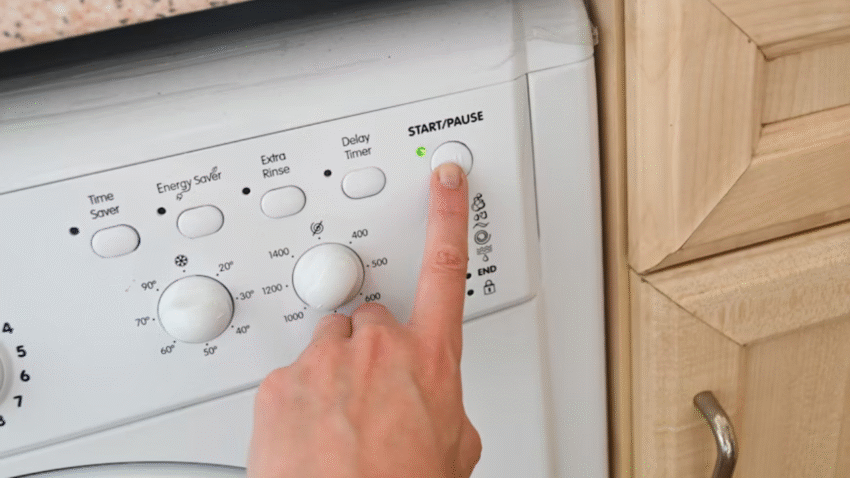Introduction
Few laundry disasters are as frustrating as pulling your clothes out of the washer only to find your crisp whites turned pink or your favorite shirt dulled by unwanted dye transfer. Color bleeding happens when loose dye from one garment transfers to another during washing — and once it sets, it’s almost impossible to remove. Learning how to stop colors from bleeding in the wash will protect your clothes, keep them vibrant, and save you the headache of laundry mishaps.
Why Preventing Color Bleeding Matters for Your Laundry Room
Color bleeding is more than just a cosmetic problem — it can permanently damage fabrics and waste hours of your time trying to fix stains. Preventing it:
- Keeps colors bright for longer wear.
- Saves money by extending the life of your clothing.
- Reduces laundry stress by avoiding accidental dye transfer.
- Maintains fabric quality by preventing excess washing to correct mistakes.
Whether you’re washing brand-new jeans, colorful t-shirts, or patterned dresses, a few simple steps can stop colors from bleeding in the first place.
Step-by-Step Guide to Stop Colors from Bleeding in the Wash
Step 1: Read Clothing Labels
Always check care tags before washing. If the label says “wash separately,” “cold water only,” or “color may run,” treat it as a warning sign.
Step 2: Sort Your Laundry by Color
Divide your laundry into three main groups:
- Lights (whites, pastels, light grays)
- Darks (blacks, dark blues, browns)
- Brights (reds, yellows, purples, bold patterns)
Sorting ensures high-risk items don’t share the same wash load with light-colored fabrics.
Step 3: Wash New Clothes Separately
New garments — especially dark jeans, red shirts, or brightly patterned items — are more likely to bleed dye in their first few washes. Wash them alone or with similar colors for at least the first 3–5 washes.
Step 4: Use Cold Water
Hot water opens fabric fibers, allowing dye to escape more easily. Cold water keeps fibers closed and helps lock in color. Always wash bright or dark clothes in cold water unless otherwise stated on the label.
Step 5: Turn Clothes Inside Out
Turning garments inside out reduces friction on the fabric surface, minimizing dye release and preventing fading.
Step 6: Use a Color-Catching Sheet
Color catcher sheets are laundry-safe sheets that trap loose dye during the wash cycle. Simply toss one into the load — especially when washing mixed colors.
Step 7: Add Vinegar or Salt to the Wash (Optional)
Some people swear by adding ½ cup of white vinegar or ½ cup of salt to the wash to help set colors. While results can vary, it’s worth trying for new clothes or items prone to bleeding.
Step 8: Avoid Overloading the Washer
When the machine is overloaded, clothes rub against each other more, causing dye to transfer. Leave enough room for clothes to move freely in the water.
Step 9: Remove Clothes Promptly
Leaving wet clothes sitting in the washer can increase dye transfer. Remove items immediately after the cycle finishes and dry them promptly.
Common Mistakes to Avoid
- Washing All Colors Together
- Mistake: Throwing everything into one load increases bleeding risk.
- Solution: Sort laundry every time.
- Ignoring Care Labels
- Mistake: Overlooking “wash separately” warnings can ruin multiple garments.
- Solution: Always read and follow label instructions.
- Using Hot Water for Darks and Brights
- Mistake: Heat makes colors bleed faster.
- Solution: Use cold water for color-rich items.
- Skipping the First Wash Rule for New Clothes
- Mistake: New fabrics often release excess dye.
- Solution: Wash separately for the first few washes.
- Letting Wet Clothes Sit Too Long
- Mistake: Damp fabric encourages dye transfer.
- Solution: Remove promptly and dry.
Extra Laundry Tips & Hacks to Keep Colors Vibrant
- Wash Less Frequently: Unless heavily soiled, bright and dark clothes last longer when washed less often.
- Air Dry in the Shade: Direct sunlight can fade colors, so dry clothes in the shade when possible.
- Use a Gentle Cycle: Less agitation means less friction, which reduces dye release.
For more fabric care ideas, check out our guide on How to Fold Laundry Fast and Efficiently to keep your clothes neat and organized after washing.
Conclusion
Stopping colors from bleeding in the wash comes down to prevention. By sorting laundry, using cold water, washing new items separately, and trying color catcher sheets, you can protect your clothes and keep them looking as good as the day you bought them. A little extra care on laundry day means your favorite colors will last for years.
Bookmark this guide so you can say goodbye to pink socks and dull t-shirts for good.
